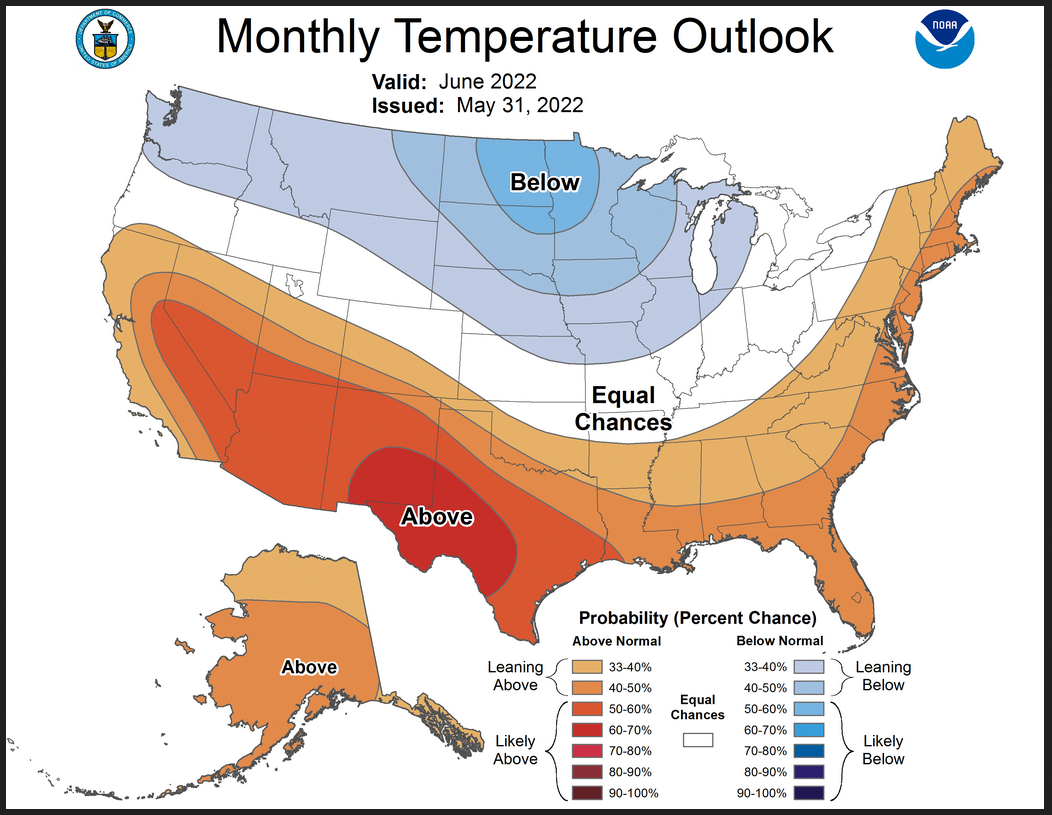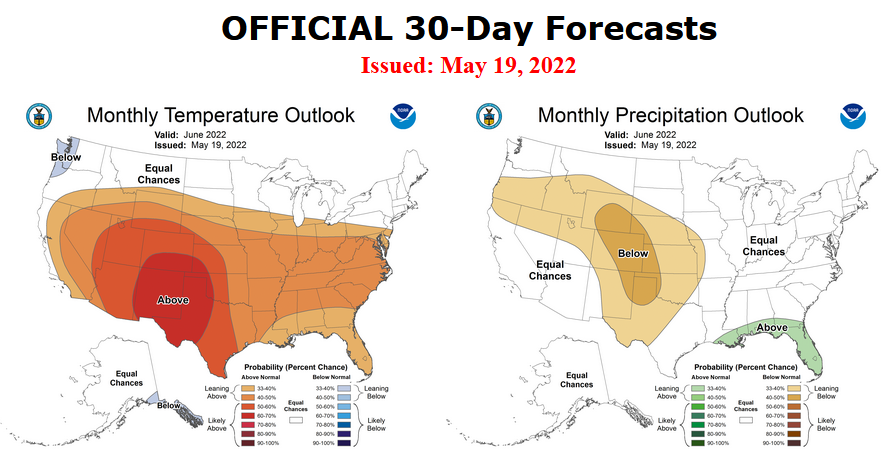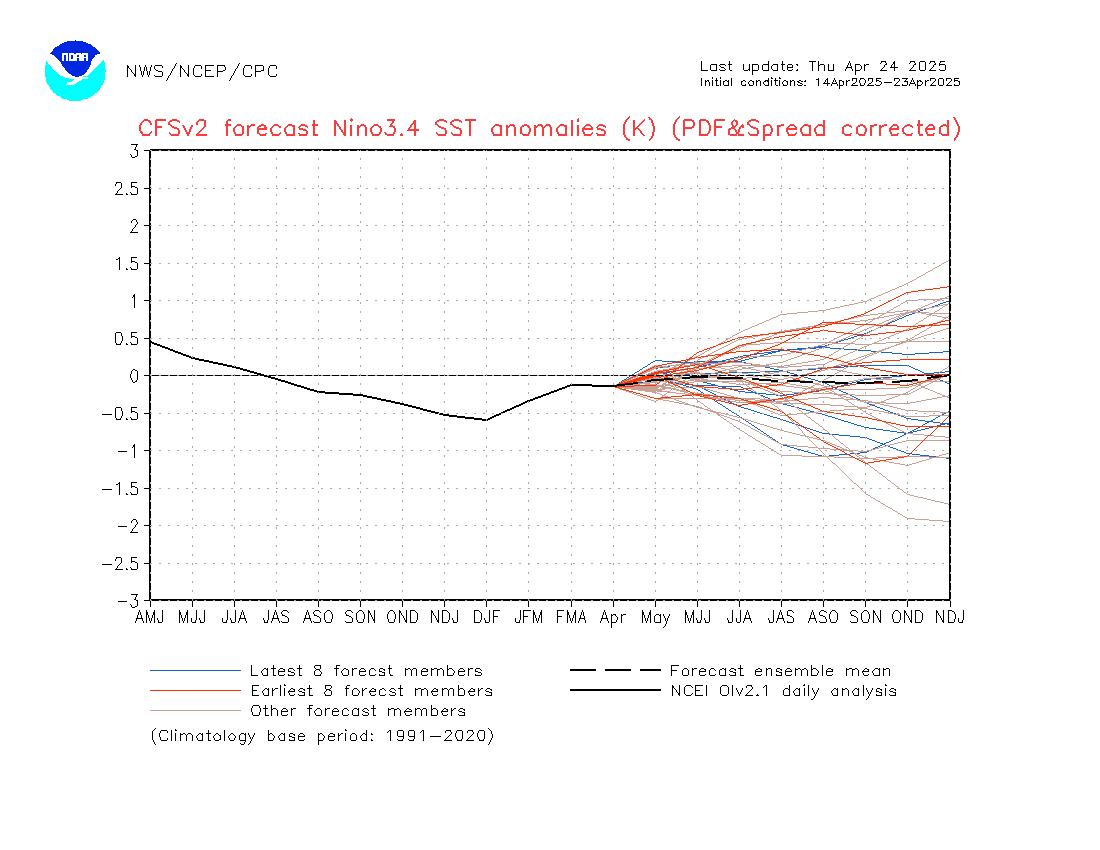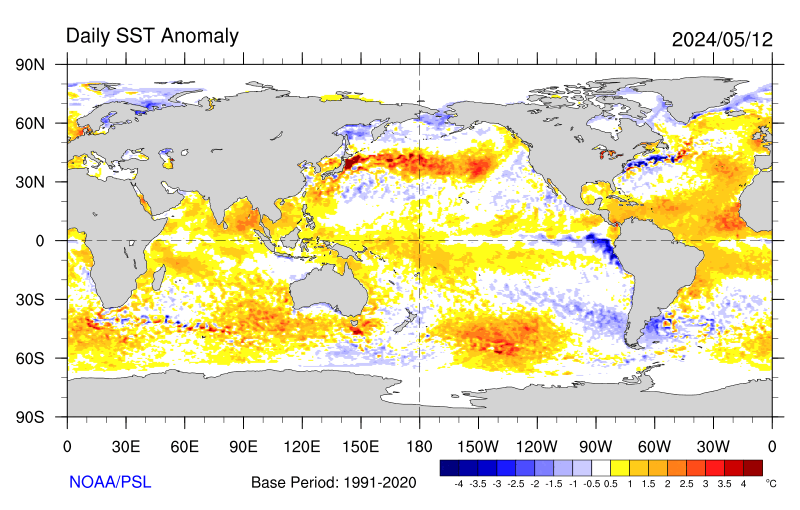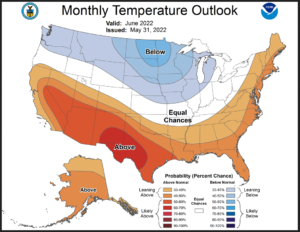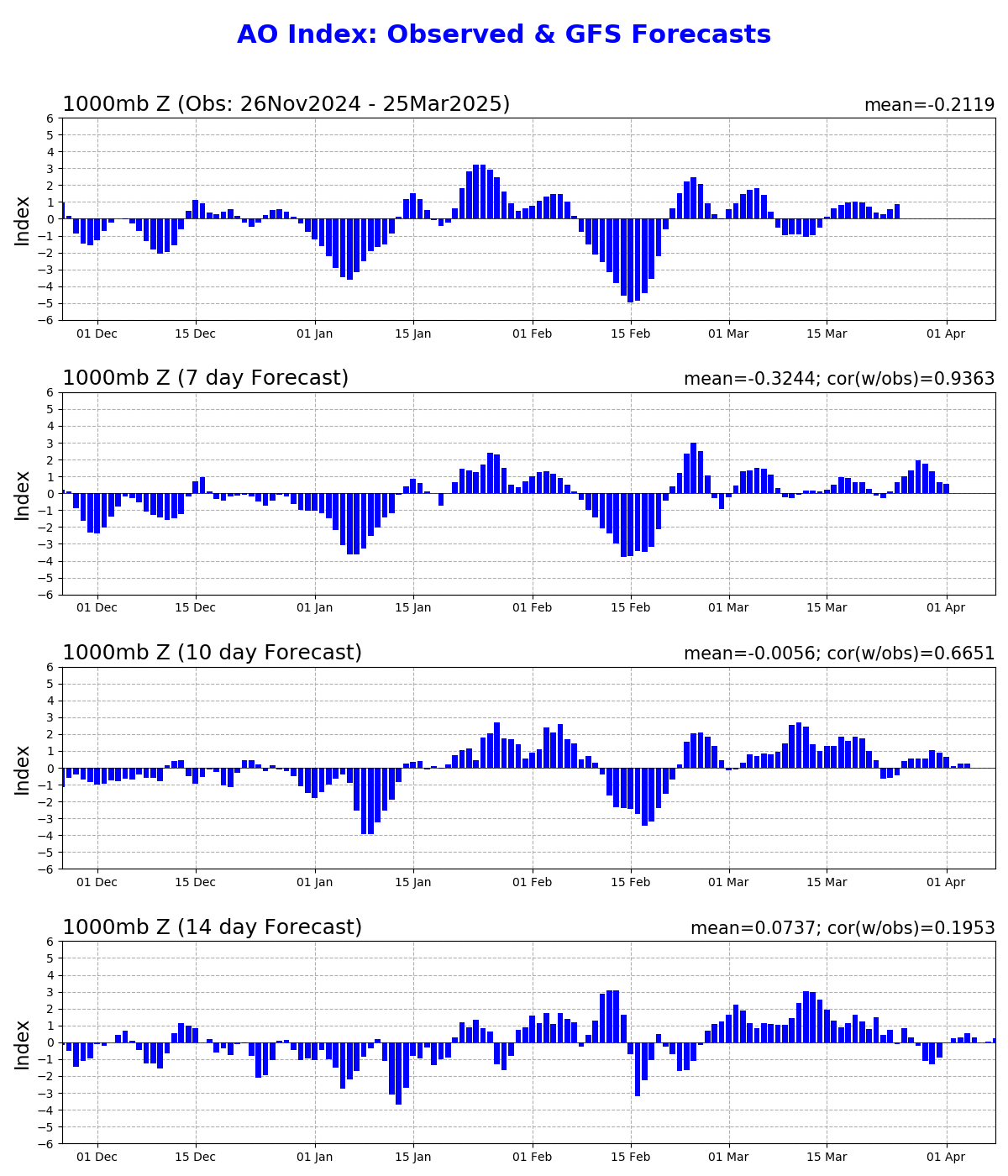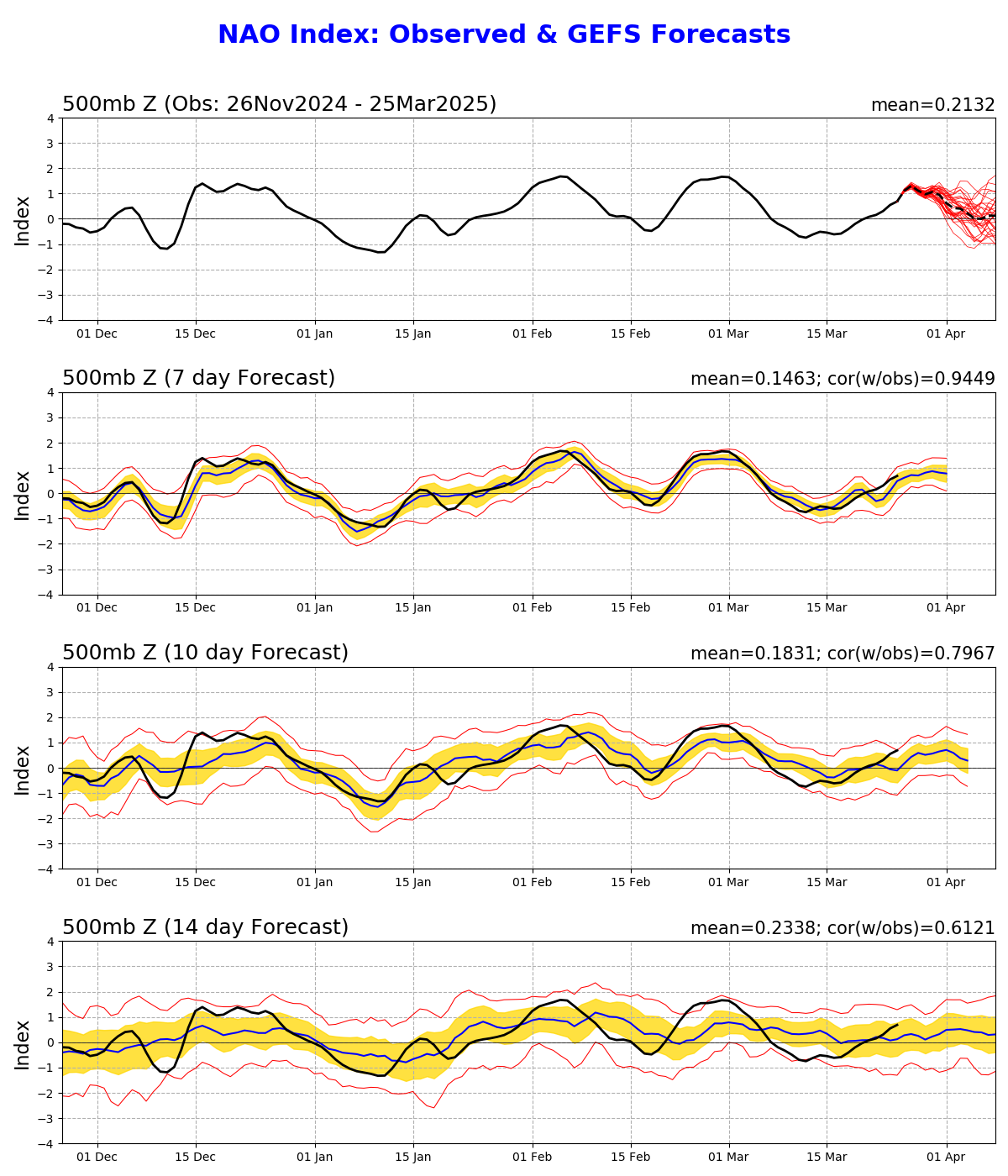There has been a large change in the weather outlook for June from NOAA.
At the end of every month, NOAA updates their Early Outlook for the following month which in this case is June. They also issue a Drought Outlook for the following month and update the three-month Drought Outlook. We are reporting on that tonight. The updated Outlook is quite different from the Early Outlook which NOAA now calls the Mid-Month Outlook. For temperature, the above-normal area is smaller than the Mid-Month Outlook and a large intrusion of colder air is expected along much of the Northern Tier. The drier than normal area is significantly reduced from the Mid-Month Outlook and shifted a bit and there are two additional areas of wetter than normal in the Outlook.
We provide partial-month outlooks for the first 24 days of June which allows us to somewhat assess if the Monthly Outlook is consistent with the partial month forecasts and it generally is. But we will not be able to answer that question definitively until the Week 3-4 Outlook is issued on Friday.
We also provide enough information for readers to understand any changes from the Mid-Month Outlook and we try to figure out why these changes were made. Many of the changes are explained in the NOAA discussion which is included in the article. The partial-month forecasts that we have provided show how NOAA thinks this will play out as the weather pattern evolves during June.
There is also a discussion of the ENSO condition which is slightly different than what NOAA used to develop the Mid-Month Outlook. The Negative Arctic Oscillation (AO) expected in the first half of June is a major factor.
We have also begun our tropical storm coverage. Yes, it is that time of the year.

Here is the updated Outlook for June.
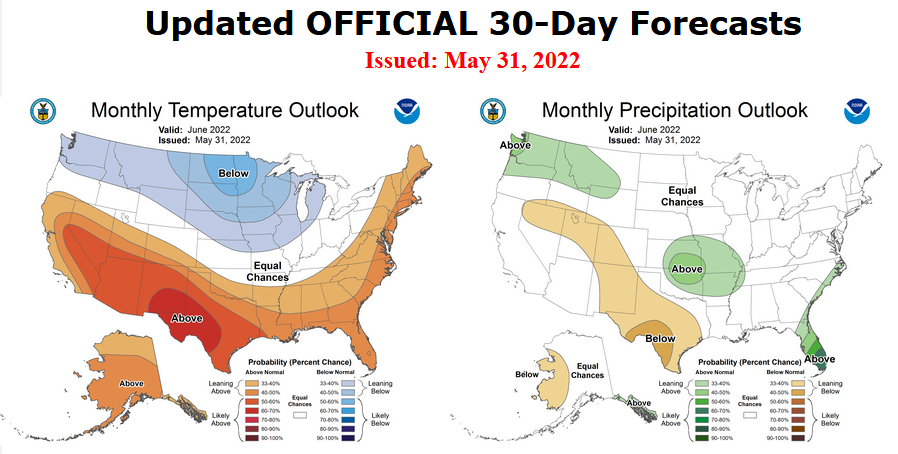
Combination of the Updated Outlook for June and Three-Month Outlook
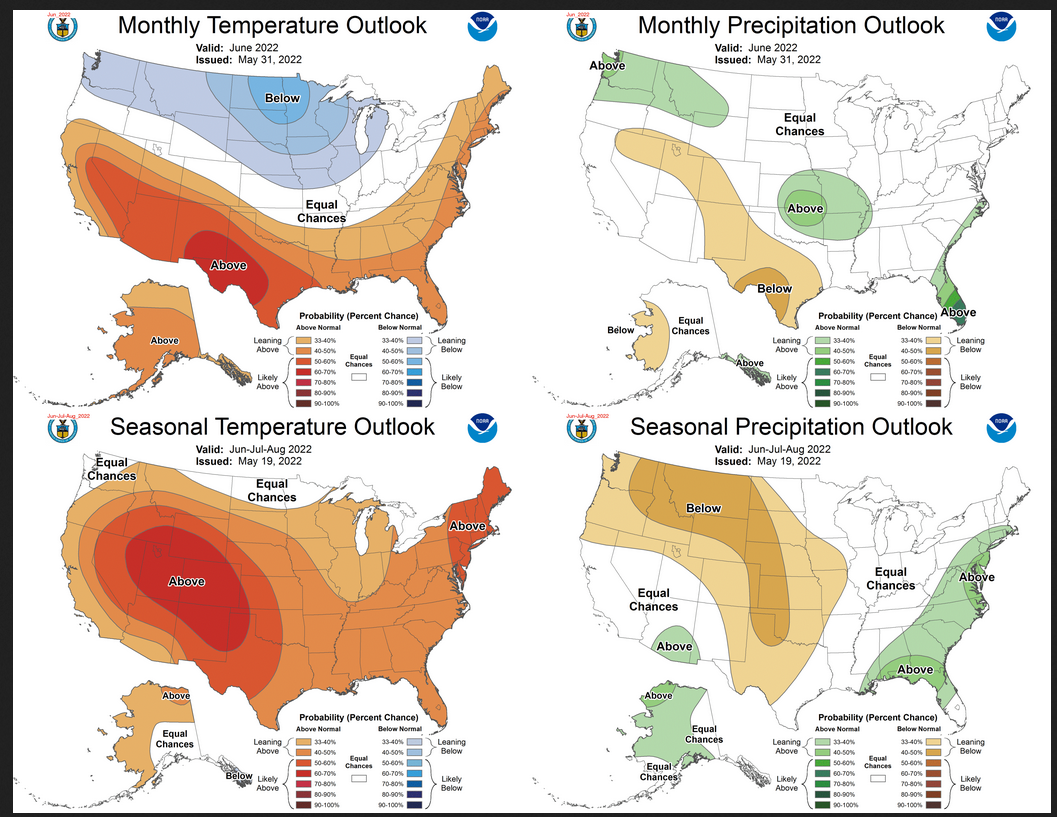
Notice that for both temperature and precipitation, the June Outlook and three-month Outlook are not similar. This suggests that the July/August Outlook if shown would be different than either the June Outlook or the Three-Month Outlook. For temperature, the June single-month Outlook shows a smaller area of above-normal temperatures with most of the Northern Tier being cooler than Normal. For precipitation, the June single-month Outlook shows a wet area in the Northwest extending through much of Montana that is not in the three-month Outlook Plus there is a wet anomaly in the South-Central Great Plains and of course, the Monsoon which is predicted to be above average for part of Arizona. There are many other differences also.
There are some reversals in the new forecast for June relative to the three-month forecast. So in some places which are forecast in June as being warmer than normal may for the three-month period be cooler than normal or vice versa. And some places that are forecast to be drier than normal in June are forecast to be wetter than normal for the three-month period.
| For both temperature and precipitation, if you assume the colors in the maps are assigned correctly, it is a simple algebra equation to solve the month two/three anomaly probability for a given location = (3XThree-Month Probability – Month One Probability)/2*. So you can derive the month two/three outlook this way. You can do that calculation easily for where you live or for the entire map. |
It is important to remember that the June Outlook was updated and the three-month Outlook was issued on May 19. So we always wonder if a change in the one-month outlook suggests that the three-month outlook would need to also be adjusted. I think that in this case, the answer may be yes but I am not going to attempt to second guess NOAA on this.
Here are larger versions of the Temperature and Precipitation Outlook maps
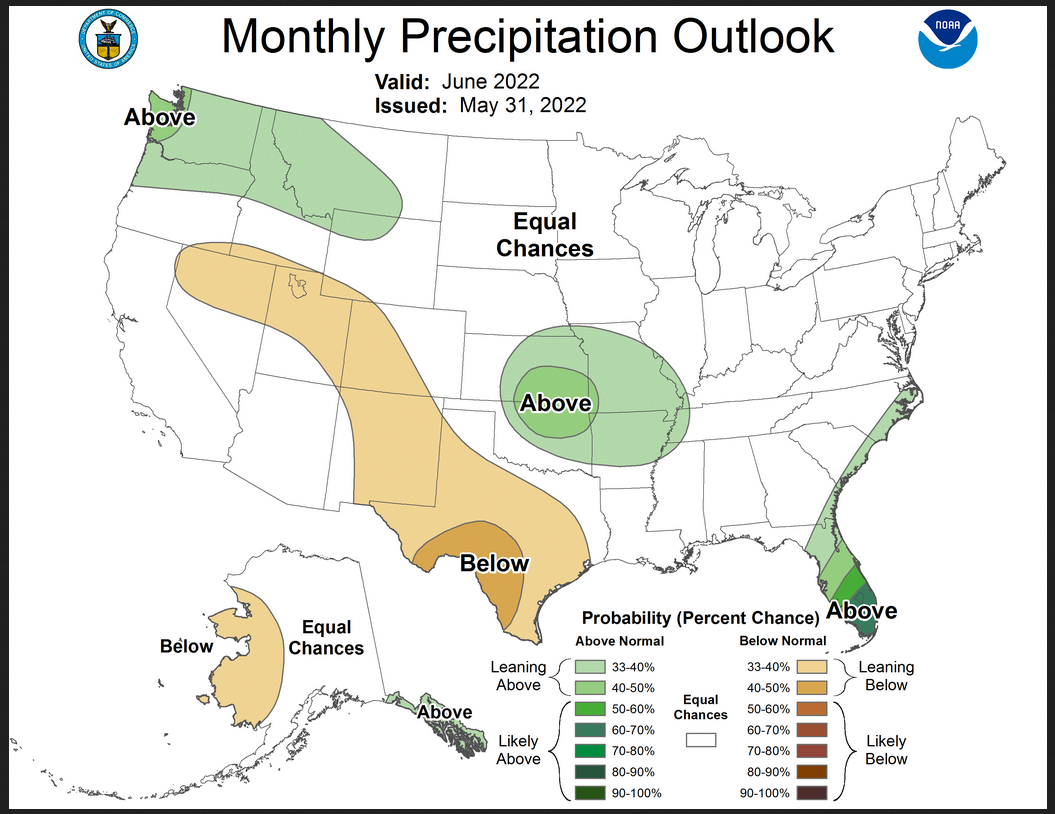
NOAA Discussion (I have shown certain important points in bold type)
30-DAY OUTLOOK DISCUSSION FOR June 2022
The updated monthly temperature and precipitation outlooks for June 2022 are based on the latest dynamical model guidance, WPC temperature and precipitation forecasts during the first week of the month, the CPC 6-10/8-14 day temperature and precipitation outlooks, and climate linkages to current soil moisture. The GEFS and ECMWF ensemble means depict either another Kelvin wave or an emerging Madden-Julian Oscillation (MJO) propagating eastward over the Western Hemisphere during early to mid-June which would maintain an elevated chance for tropical cyclone (TC) development across the western Caribbean Sea or southern Gulf of Mexico. Please refer to CPC’s Global Tropics Hazards for updates on the MJO along with TC development forecasts throughout June.
The most notable change to the previous June temperature outlook, released on May 19, is the introduction of a favored area of below normal temperatures from the north-central CONUS westward to parts of the Pacific Northwest. The Arctic Oscillation (AO) index rapidly became negative during late May as positive 500-hPa heights developed over the higher latitudes of the Northern Hemisphere. This transition to a negative AO is likely to contribute towards below-normal temperatures for the northern tier of the CONUS during the first two weeks of June. The GEFS and ECMWF week 3-4 temperature outlooks support a continuation of the cooler-than-normal temperatures for the Pacific Northwest, northern Rockies, and northern Great Plains through late June. High soil moisture (above the 90th percentile) across the Red River Valley of the North was also a factor for increasing probabilities to above 50 percent for below-normal temperatures. Temperature tools at all time scales throughout June generally predict above-normal temperatures across the southern tier of the CONUS, California, and along the East Coast. The largest probabilities (above 60 percent) of above-normal temperatures coincide with the lowest soil moisture across eastern New Mexico and western Texas and are also consistent with temperature tools during early to mid-June.
As of May 31, model solutions remain consistent that there is an increased chance of an early season TC forming across the northwestern Caribbean Sea or southeastern Gulf of Mexico during the first few days of June. Given the most likely track of this potential TC northeastward and WPC 7-day rainfall amounts of more than 5 inches, probabilities for above-normal precipitation exceed 60 percent across south Florida. Above-normal precipitation is favored for parts of the south-central Great Plains eastward to the middle Mississippi Valley due to periods of moderate to heavy rainfall during the first week of June and favored near to above-normal precipitation associated with northwest flow aloft along a thermal gradient, through mid-June. Although there is expected to be a favorable pattern for episodes of convective rainfall for the northern Great Plains, equal chances (EC) of below, near, or above-normal precipitation are forecast since the storm track is expected to be displaced southward to start the month. The GEFS and ECMWF ensemble means depict a longwave trough over the northeastern Pacific for much of June which favors above-normal precipitation across parts of the Pacific Northwest and northern Rockies. Due to predicted anomalous 500-hPa ridging for much of June, probabilities for below-normal precipitation are slightly elevated for parts of the Great Basin, Southwest, and western to central Texas. Based on the expectation of a variable precipitation pattern during early to mid-June, mixed signals among the week 3-4 guidance, and inherent uncertainty spatially with convective rainfall, EC is forecast for the precipitation outlook across the Corn Belt and much of the eastern CONUS.
Ensemble means depict above normal 500-hPa heights persisting over Alaska through mid to late June, favoring above normal temperatures for the state. A mean 500-hPa trough over the northeastern Pacific and week-2 precipitation tools support a slight lean towards above-normal precipitation for the Alaska Panhandle. Based on a likely dry start to the month and good consistently among daily CFS model runs, below-normal precipitation is favored for western Mainland Alaska.
What is the North Atlantic Oscillation
I have shown the current forecasts at the end of this article. They may or may not update automatically in the article.
One way to get a handle on what has changed is to compare the updated June Outlook with the Early/Mid-Month Outlook for June issued on May 19, 2022. They are now calling that the Mid-Month Outlook.
|
|
 |
Visual Consistency Testing.
What I am going to try to do is show the 5-day Outlook, 6 – 10 day Outlook, 8 – 14 day Outlook, and Week 3-4 Outlook. Since this is a Tuesday, this will give us 24 days of Outlooks out of 30 days in June. So it should be pretty good. We may update this analysis after the next Week 3 -4 Update this coming Friday.
I am going to have small images that I think you will be able to click on them to make them larger. I also think that they will auto-update. Thus you have a weather forecasting system here.
Let’s see what we get
First Temperature
| Maximum Temperature Day 3 | Days 6 – 10 | Days 8 – 14 | Weeks 3-4 |
 |
 |
 |
 |
At this point in time, we have 24 days of short-term precipitation Outlooks for June which has 30 days. The full month Outlook seems to be consistent with the short-term Outlooks. I believe the short-term Outlooks will update in the article but I am not sure of that. If it does, you actually have an article that is sort of an outlook forecast that continually updates.
There is a fair amount of variation throughout the month.
And then Precipitation
| Cumulative Days 1 – 5 | Days 6 – 10 | Days 8 – 14 | Weeks 3-4 |
 |
 |
 |
 |

At this point in time, we have 24 days of short-term forecasts for June which has 30 days. It seems to be somewhat consistent with the short-term forecasts. I believe the short-term forecasts will update in the article but I am not sure of that or exactly when they will. We do not have the fourth week of June forecast yet so I am not confident to say that the monthly forecast is insufficiently wet for the extended Northwest.
Drought Outlook
Here is the newly issued Drought Outlook for June 2022
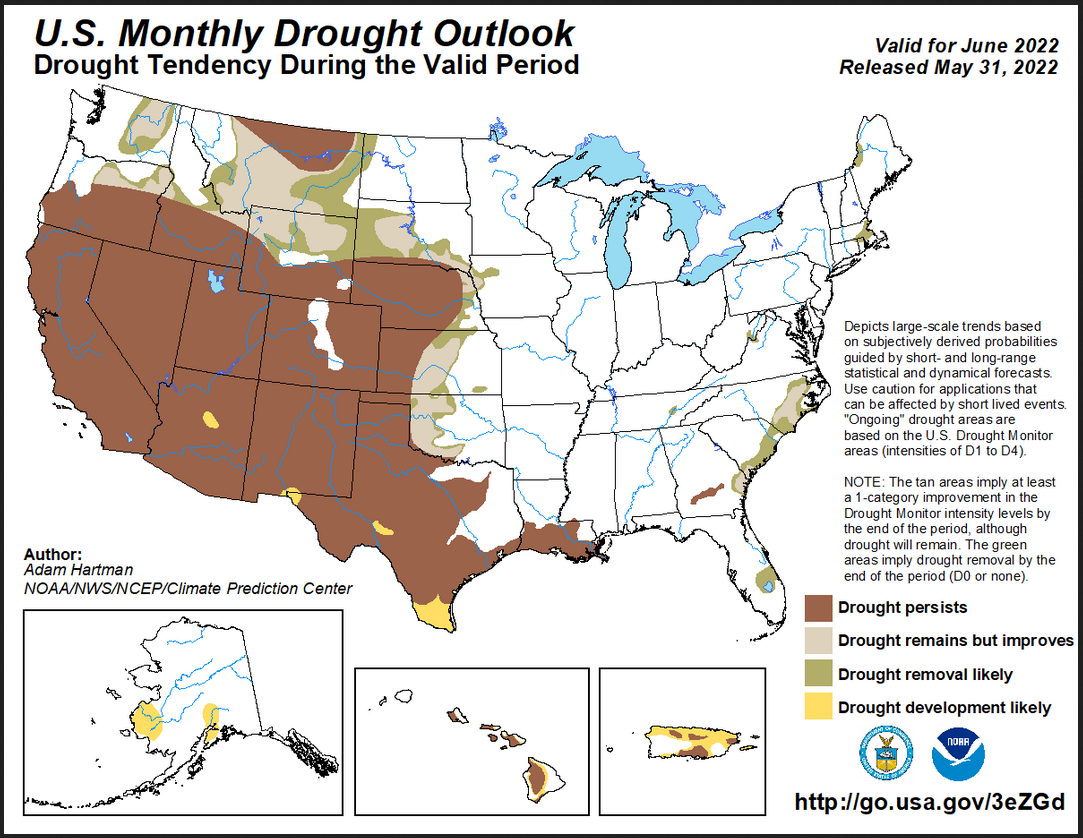
It looks like a big reduction in the area in drought. The summary and detailed discussions that accompany this graphic can be accessed here https://www.cpc.ncep.noaa.gov/products/expert_assessment/mdo_summary.php
This is something new. They now provide an updated Seasonal Outlook
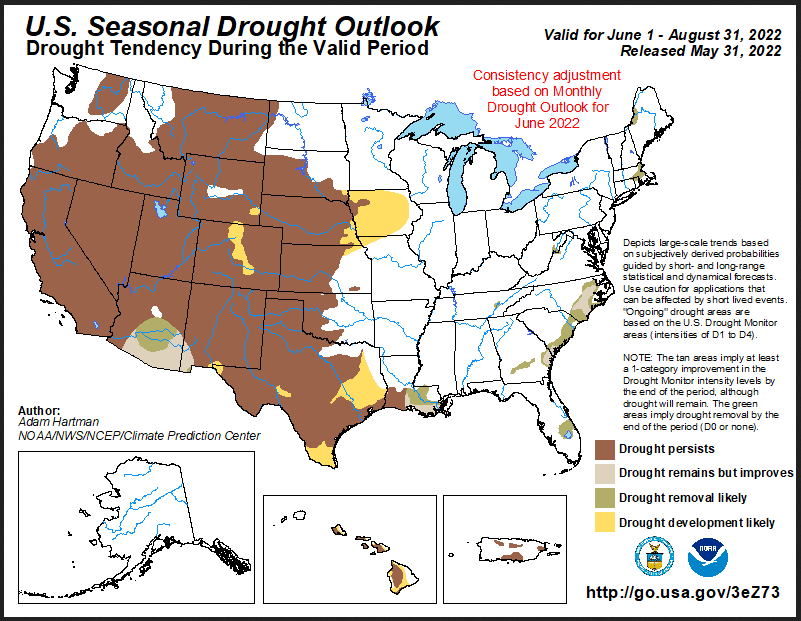
It does not look as good. And here is the link https://www.cpc.ncep.noaa.gov/products/expert_assessment/sdohomeweb.png
Has There Been a Change in the ENSO Outlook?
We actually discussed this when I reported on the NOAA Seasonal Outlook which you can read by clicking here https://econcurrents.com/2022/05/13/noaa-updates-the-enso-forecast-on-may-12-2022-chances-of-a-la-nina-three-peat-are-61/
The key information used by NOAA follows.


| For purposes of looking at the June Outlook. we are interested in the MJJ and JJA forecasts and they have changed ever so slightly towards ENSO Neutral. |
What Does the NOAA Proprietary ENSO Model Forecast?
| It actually forecasts ENSO Neutral or borderline La Nina for June. -0.5C is the cutoff point for La Nina. |
The below should auto-update. If it does not update you can click here https://www.cpc.ncep.noaa.gov/products/people/wwang/cfsv2fcst/images3/nino34SeaadjPDFSPRDC.gif This model no longer shows La Nina continuing indefinitely. It had been showing that for some time but NOAA relies more on the IRI Forecast. But perhaps this model is now showing that we are becoming ENSO Neutral with a strong La Nina bias. So this is not a major change but it may be enough of a change to have things be less extreme.
This shows the current actual situation looking at the Sea Surface Temperature. I am not addressing the response of the atmosphere which is what confirms the state of ENSO. To impact CONUS weather or weather anywhere in the world, the Walker Circulation (I am not going to explain that tonight) has to respond to the Sea Surface Temperature. It has been responding so we do not need to discuss it with respect to the June Outlook. But to move out of La Nina to ENSO Neutral the Walker circulation will have to respond.
| Notice that most of the blue (cool) area is south of the Equator and the blue area extends to the west and north of the Equator there are gaps in the blue. One can also see that we remain in PDO-(Neg). The water is cool (compared to normal) along the west coast of North America with the warm anomaly out to sea. That is characteristic of PDO-(Neg) |
Where is ENSO Measured?

You can mentally superimpose the Nino 3.4 area shown encompassing part of the yellow and part of the red areas in the above map and you can see that it is cool in the Nino 3.4 area especially South of the Equator. That is an oddity of this La Nina that is both westerly displaced and focused mostly south of the Equator. There is not much discussion of that and how that might impact our weather.
How About the Future?
ENSO is measured at the surface of the ocean because it is the surface that interacts with the atmosphere. But the surface changes over time so we pay a lot of attention to the subsurface. Here is what it looks like now. Does it look like it will soon be other than cool? It is complicated because we are looking at anomalies not absolute temperatures and we are only looking at a cross-section at the Equator when the Nino 3.4 Area extends five degrees north and south of the Equator but there is only so much information that can be presented in one graphic. Sea Surface Temperature Anomalies are only one component of ENSO but probably the most important component and La Nina is relative to SSTA is defined as -0.5C or colder.
I am showing five snapshots of the situation each of which is centered on a five-day period of time. The most recent one is at the top of the stack. Here we are just looking at the Equator but from the surface down to 450 meters. And we are looking at the temperature anomalies. The Nino 3.4 Index is measured at the surface but the subsurface may become the future surface. There is anomalously cool water almost everywhere on the surface. Off to the west, the warm Indo-Pacific Warm Pool has moved back and forth from west to east from prior months but it is quite intense with maximum anomalies in a small area of 4 degrees Celsius (you can see the +3C area more easily. And we must remember that these anomalies are calculated based on the seasonal norms for water at that depth. So four degrees warmer than usual does not mean it is warmer than the water at the surface. So it will not automatically rise.
Analysis Updates
I realize that is complicated. But it is important to understand. The analysis updates every five days but the graphics in this article are frozen. However, an updated version of this graphic can be found at https://www.cpc.ncep.noaa.gov/products/analysis_monitoring/ocean/weeklyenso_clim_81-10/wkteq_xz.gif. It comes with an upper graphic like the images shown below which is the temperature anomalies. It also has a lower graphic which is the actual water temperatures. Both are useful.
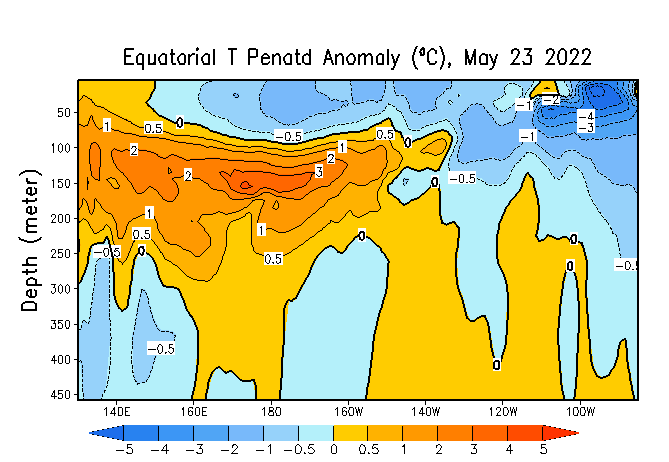 |
 |
 |
 |
 |
How Does it All Net Out?
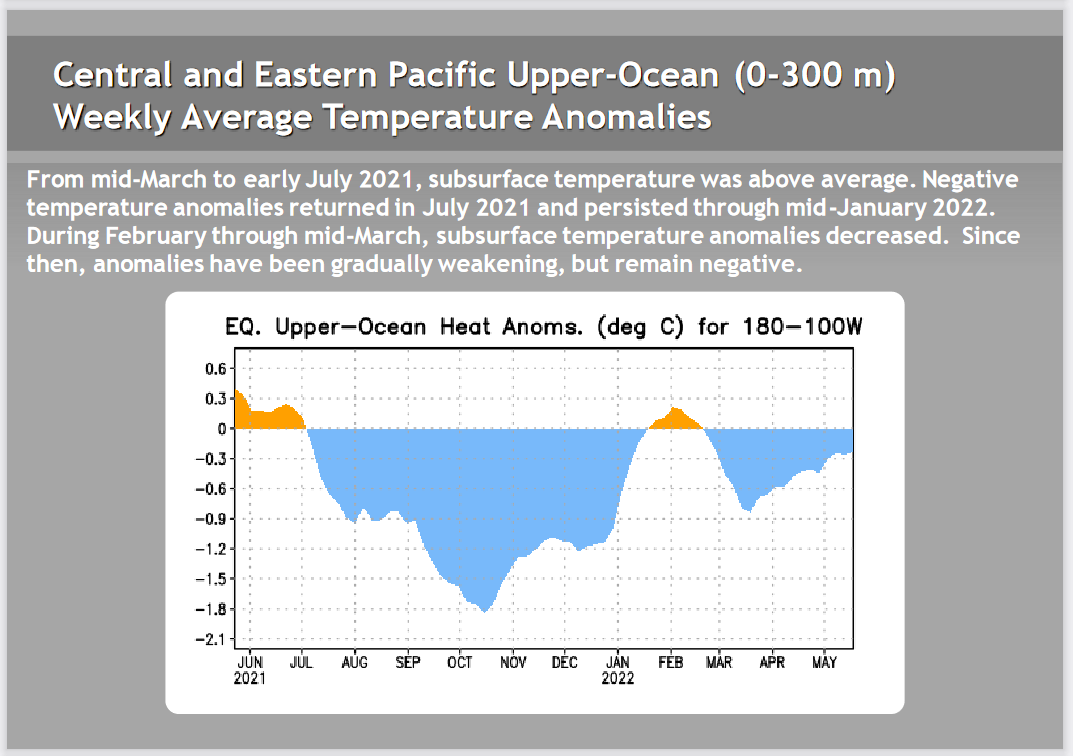
| Basically in the above, the anomalies from all depths are averaged out so it seems that the overall cool anomaly is slowly weakening. But you can not take that for granted since there are cool currents that enter the area. |
Possible Tropical Events
This provides a five-day outlook. I expect this image to update in the article. But if it does not you can refresh it by clicking here. https://www.nhc.noaa.gov/xgtwo/two_atl_5d0.png
First the Atlantic:
And then the Eastern Pacific. With La Nina conditions we expect more activity in the Eastern Pacific than the Atlantic for June. I expect this image to update but if not you can click here https://www.nhc.noaa.gov/xgtwo/two_pac_5d0.png
Sometimes it is useful to take a look at Persistence. Is the June Outlook similar to the May reported weather?
Looking back on May 2022 to relate the forecast for June to the actual for May.
Here is the actual for May minus one day on the left and the updated Outlook for June on the right. One row is for temperature and the bottom row is for precipitation.
| May Actual (30 0f 31 Days) | June Updated Outlook | |
| Temperature | 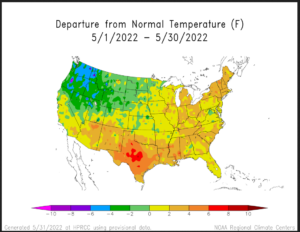 |
|
| Precipitation | 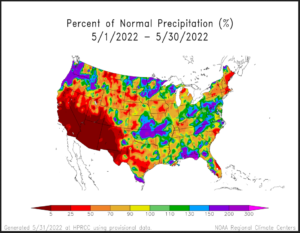 |
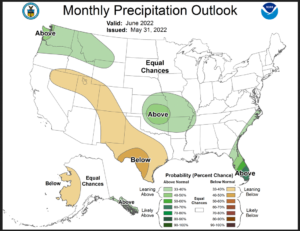 |
There seems to be substantial persistence meaning that June is expected to be somewhat similar to May in terms of variation from Normal with respect to both temperature and precipitation. Of course, Normal for June is different than Normal for May
The images above are frozen. But if you want to find month-to-date temperature or precipitation there are the links.
Month to date Temperature can be found at https://hprcc.unl.edu/products/maps/acis/MonthTDeptUS.png
Month to date Precipitation can be found at https://hprcc.unl.edu/products/maps/acis/MonthPNormUS.png
